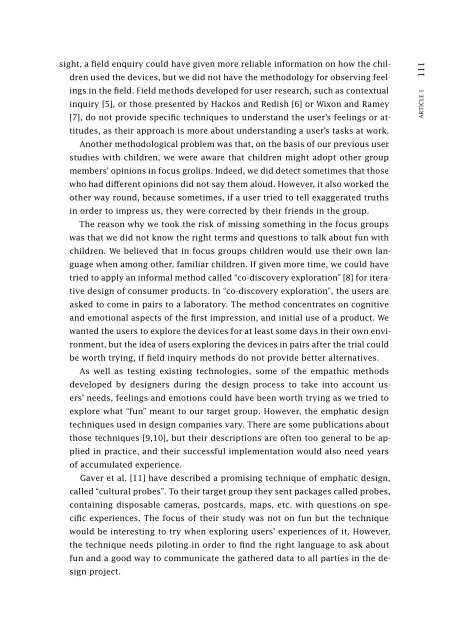Co-experience: Understanding user experiences in social interaction
Co-experience: Understanding user experiences in social interaction
Co-experience: Understanding user experiences in social interaction
You also want an ePaper? Increase the reach of your titles
YUMPU automatically turns print PDFs into web optimized ePapers that Google loves.
sight, a field enquiry could have given more reliable <strong>in</strong>formation on how the children<br />
used the devices, but we did not have the methodology for observ<strong>in</strong>g feel<strong>in</strong>gs<br />
<strong>in</strong> the field. Field methods devel oped for <strong>user</strong> research, such as contextual<br />
<strong>in</strong>quiry [5], or those presented by Hackos and Redish [6] or Wixon and Ramey<br />
[7], do not provide specific techniques to understand the <strong>user</strong>’s feel<strong>in</strong>gs or attitudes,<br />
as their approach is more about understand<strong>in</strong>g a <strong>user</strong>’s tasks at work.<br />
Another methodological problem was that, on the basis of our previous <strong>user</strong><br />
studies with children, we were aware that children might adopt other group<br />
members’ op<strong>in</strong>ions <strong>in</strong> focus grolips. Indeed, we did detect sometimes that those<br />
who had different op<strong>in</strong>ions did not say them aloud. However, it also worked the<br />
other way round, because sometimes, if a <strong>user</strong> tried to tell exaggerated truths<br />
<strong>in</strong> order to impress us, they were corrected by their friends <strong>in</strong> the group.<br />
The reason why we took the risk of miss<strong>in</strong>g someth<strong>in</strong>g <strong>in</strong> the focus groups<br />
was that we did not know the right terms and questions to talk about fun with<br />
children. We believed that <strong>in</strong> focus groups children would use their own language<br />
when among other, familiar children. If given more time, we could have<br />
tried to apply an <strong>in</strong>formal method called “co-discovery exploration” [8] for iterative<br />
design of consumer products. In “co-discovery exploration”, the <strong>user</strong>s are<br />
asked to come <strong>in</strong> pairs to a laboratory. The method concentrates on cognitive<br />
and emotional aspects of the first impression, and <strong>in</strong>itial use of a product. We<br />
wanted the <strong>user</strong>s to explore the devices for at least some days <strong>in</strong> their own environment,<br />
but the idea of <strong>user</strong>s explor<strong>in</strong>g the devices <strong>in</strong> pairs after the trial could<br />
be worth try<strong>in</strong>g, if field <strong>in</strong>quiry methods do not provide better alternatives.<br />
As well as test<strong>in</strong>g exist<strong>in</strong>g technologies, some of the empathic methods<br />
developed by designers dur<strong>in</strong>g the design process to take <strong>in</strong>to account <strong>user</strong>s’<br />
needs, feel<strong>in</strong>gs and emotions could have been worth try<strong>in</strong>g as we tried to<br />
explore what “fun” meant to our target group. However, the emphatic design<br />
techniques used <strong>in</strong> design companies vary. There are some publications about<br />
those techniques [9,10], but their descriptions are often too general to be applied<br />
<strong>in</strong> practice, and their suc cessful implementation would also need years<br />
of accumulated <strong>experience</strong>.<br />
Gaver et al. [11] have described a promis<strong>in</strong>g technique of emphatic design,<br />
called “cultural probes”. To their target group they sent packages called probes,<br />
conta<strong>in</strong><strong>in</strong>g disposable cameras, postcards, maps, etc. with questions on specific<br />
<strong>experience</strong>s. The focus of their study was not on fun but the technique<br />
would be <strong>in</strong>terest<strong>in</strong>g to try when explor<strong>in</strong>g <strong>user</strong>s’ <strong>experience</strong>s of it. However,<br />
the technique needs pilot<strong>in</strong>g <strong>in</strong> order to f<strong>in</strong>d the right language to ask about<br />
fun and a good way to communicate the gathered data to all parties <strong>in</strong> the design<br />
project.<br />
ARTICLE 1 111

















